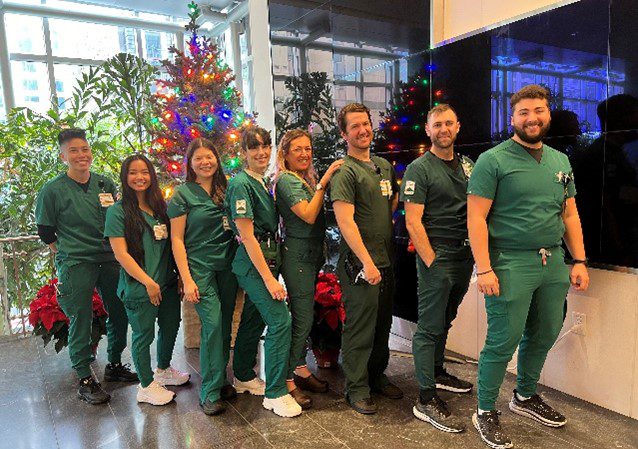Many nurses who’ve enjoyed long careers will tell you it was never a job, but a calling. They were meant to provide care to others and help them heal. As a profession, nursing offers strong growth potential, stability and flexibility, emotional fulfillment and competitive pay, yet workforce shortages persist in California and nationwide. Staffing shortfalls swelled during the coronavirus pandemic and have not fully rebounded.
Like many professions, starting on the right foot is key to building a long and deeply satisfying career. This is particularly true for nurses who work in acute care settings like hospitals. But the first year can prove overwhelming and difficult for some. The American Nurses Association reports nearly 18% of newly licensed registered nurses, or RNs, quit within the first year. Some never return. This is problematic considering the number of Americans who need hospitalized care is only expected to grow.
One way to help new nurses enter their first job successfully is through supervised training. For this reason, partnerships between nursing schools and hospitals are critical.
Sutter Health’s California Pacific Medical Center in San Francisco is proud of its long-time partnership with the College of Marin, located about 20 minutes north of the city.
“College of Marin nursing students get hands-on experience at CPMC’s large Van Ness campus,” says Elena Todorova, clinical instructor at CPMC and assistant director and nursing faculty member for College of Marin.
Todorova says students rotate through multiple departments at CPMC, including medical-surgical and pediatrics, getting to apply the skills they’ve learned in the classroom under the guidance of seasoned nurses.
“It’s one thing to master abstract concepts in the classroom. It’s another thing entirely to put freshly acquired knowledge and skills to use when working with real patients,” Todorova says. Training helps bridge that gap.”
In the beginning, bedside nursing is intimidating. Immersive training prepares nursing students for the realities, pressures and privileges of caring for people. Todorova adds that hands-on learning at the hospital also extends beyond patient care to collaboration with doctors and entire care teams, as well as engaging with technological systems like Sutter’s electronic health record. “It’s a front-row seat to the job and it takes place in a safe learning environment where questions and skill building are encouraged.”
Nurses in Need
Prior to the COVID-19 crisis, nursing schools in California and nationally graduated about the same number of RNs needed to fill available positions. But more nurses are needed. In fact, every U.S. state is predicted to have a deficit of nurses in the years to come and California sits at the top of the list. Projections show the Golden State could be short 44,000 RNs by 2030.
While there is no sufficient data on the number of California nursing school applications, College of Marin receives numerous submissions from qualified applicants who have already completed their prerequisite courses. In fall 2023, 399 qualified applicants applied to the college. The school admitted 43 individuals based on available seats. Todorova says College of Marin’s program enrollment for nursing has historically remained stable and is well-positioned to grow.
Nurses are often referred to as the “backbone” of the healthcare system as they represent the largest single profession within the field. Supporting a robust pipeline of these well-trained professionals is necessary and needed. The system can’t afford to lose any, especially those just starting out and poised to hold a long career.
“Nursing programs have been continuously challenged to find practice sites for the nursing students. Sutter’s CPMC has given us the opportunity to have future nurses transition to the role at a time when some hospitals are experiencing staffing shortages,” Todorova says. “Our partnership with CPMC shows these partnerships can work successfully even during a time of crisis like COVID-19 pandemic. This is important because we need to integrate more nurses into the workforce and expand nursing programs to meet the growing demand for care.”
Jonathan Becchina, a College of Marin nursing student, agrees the partnership has been an essential building block as he prepares to enter the field. Becchina says, “My clinical experience at CPMC has taught me the value of providing exceptional care. Caring for patients and their recovery is a very intimate experience. Not only do we have an opportunity to make a difference in people’s lives, but their family members also rely on our teams for support and education. The nurses, staff and administrators at CPMC provide us with an invaluable foundation to continue our education and set us up for success when we enter the workforce. I could not have asked for a better experience than at CPMC!”
College of Marin Nursing School Program History
The nursing program at College of Marin was founded due to severe nursing shortages in hospitals following World War II. The program received initial accreditation from the California Board of Registered Nursing in February 1965, and the first class was admitted in fall 1965. Throughout the last 58 years, graduates have advanced their education, earning their bachelor’s, master’s and doctoral degrees in nursing and other professional areas. Many have also gone on to assume prominent healthcare and nursing leadership positions in the Bay Area and across the nation. CPMC has previously hired College of Marin graduates, most recently for the intensive care and medical-surgical specialties.





